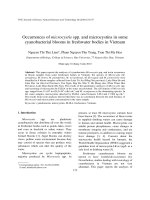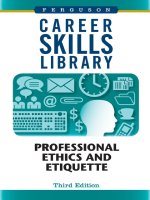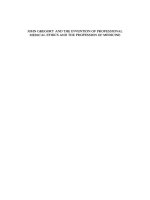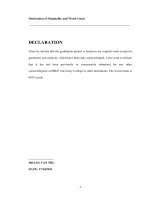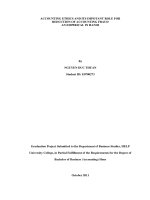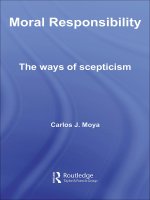Medical ethics and etiquette in classsical ayurveda
Bạn đang xem bản rút gọn của tài liệu. Xem và tải ngay bản đầy đủ của tài liệu tại đây (1.92 MB, 251 trang )
Free ebooks ==>
www.Ebook777.com
Well-Mannered Medicine
This page intentionally left blank
www.Ebook777.com
Well-Mannered
Medicine
Medical Ethics and Etiquette
in Classical Ayurveda
DA GMA R W UJA ST Y K
1
www.Ebook777.com
3
Oxford University Press is a department of the University of Oxford.
It furthers the University’s objective of excellence in research, scholarship,
and education by publishing worldwide.
Oxford New York
Auckland Cape Town Dar es Salaam Hong Kong Karachi
Kuala Lumpur Madrid Melbourne Mexico City Nairobi
New Delhi Shanghai Taipei Toronto
With offices in
Argentina Austria Brazil Chile Czech Republic France Greece
Guatemala Hungary Italy Japan Poland Portugal Singapore
South Korea Switzerland Thailand Turkey Ukraine Vietnam
Oxford is a registered trademark of Oxford University Press
in the UK and certain other countries.
Published in the United States of America by
Oxford University Press
198 Madison Avenue, New York, NY 10016
© Oxford University Press 2012
All rights reserved. No part of this publication may be reproduced, stored in a retrieval system,
or transmitted, in any form or by any means, without the prior permission in writing of
Oxford University Press, or as expressly permitted by law, by license, or under terms agreed
with the appropriate reproduction rights organization. Inquiries concerning reproduction
outside the scope of the above should be sent to the Rights Department, Oxford University
Press, at the address above.
You must not circulate this work in any other form
and you must impose this same condition on any acquirer.
Library of Congress Cataloging-in-Publication Data
Wujastyk, Dagmar.
Well-mannered medicine : medical ethics and etiquette in classical
Ayurveda / Dagmar Wujastyk.
p. cm.
Includes bibliographical references (p. ).
ISBN 978–0–19–985626–8 (hardcover : alk. paper) — ISBN
978–0–19–985996–2 (pbk. : alk. paper) — ISBN 978–0–19–985627–5 (ebook)
1. Medicine, Ayurvedic. 2. Medical ethics—India. I. Title.
R605.W85 2012
2011041072
174.2 95538—dc23
ISBN 978–0–19–985626–8
ISBN 978–0–19–985996–2
1 3 5 7 9 8 6 4 2
Printed in the United States of America
on acid-free paper
Free ebooks ==> www.Ebook777.com
Contents
Acknowledgments
vii
Abbreviations
ix
Introduction
1
1 The Pillars of Treatment
26
2 On Becoming a Physician
68
3 On Continued Learning and Interaction with Peers
106
4 To Care or Not to Care
110
5 The Rewards of Medical Practice
117
6 Veracity in the Doctor–Patient Relationship
124
7 Ethical Elisions
142
8 Concluding Reflections
147
Appendices: Sanskrit Text Passages
155
A The Pillars of Treatment
157
B On Becoming a Physician
168
C On Continued Learning and Interaction with Peers
176
D To Care or Not to Care
177
www.Ebook777.com
Free ebooks ==> www.Ebook777.com
vi
Contents
E The Rewards of Medical Practice
179
F Veracity in the Doctor–Patient Relationship
182
Notes
186
Bibliography
221
Index
229
www.Ebook777.com
Free ebooks ==> www.Ebook777.com
Acknowledgments
writing a book can be a challenging undertaking, and I am grateful for the
encouragement and support I have received from family, friends, and colleagues over the years. My special thanks go to Professor Konrad Klaus for his
supervision of my doctoral thesis. I would also like to thank Dr. Elizabeth de
Michelis, Dr. Mark Singleton, Rajashree Dhanaraj, Professor Frederick Smith,
Dr. Suzanne Newcombe, Dr. Rick Weiss, Professor Martha Selby, Professor
Jan Gerrit Meulenbeld, Professor Kenneth Zysk, Dr. Philipp Maas, Professor
Karin Preisendanz, Katrin Wellmann, and Dr. Dominik Wujastyk, who all
have contributed either directly or indirectly to this volume.
www.Ebook777.com
Free ebooks ==> www.Ebook777.com
This page intentionally left blank
www.Ebook777.com
Free ebooks ==> www.Ebook777.com
Abbreviations
Ah.
As.
Bhel.
Bh¯av.
Ca.
Cik.
H¯a.
HIML.
Ind.
K.A.
K¯as´ .
Madh.
M¯adh.
Manu.
MW.
Ni.
Purv.
¯
´ a.
S¯
´ ar.
S¯
Skt.
Si.
Su.
Su.
¯
Utt.
As.t.a¯ ngahr
˙
. dayasam
. hit¯a
As.t.a¯ ngasam
˙
graha
.
Bhelasam
. hit¯a
Bh¯avaprak¯a´sa
Carakasam
. hit¯a
Cikits¯asth¯ana, or Cikitsasth¯ana in the case of the
K¯a´syapasam
. hit¯a
H¯ar¯ıtasam
hit¯
. a
History of Indian Medical Literature
Indriyasth¯ana
Kaut.il¯ıya Artha´sa¯ stra
K¯a´syapasam
. hit¯a
Madhyakhan.d.a
M¯adhavanid¯ana
M¯anavadharma´sa¯ stra/ Manusmr.ti
Monier-Williams: A Sanskrit–English Dictionary
Nid¯anasth¯ana
Purvakhan
¯
. d.a
´ ar¯ırasth¯ana
S¯
´ arngadharasam
S¯
˙
. hit¯a
Sanskrit
Siddhisth¯ana
Su´srutasam
. hit¯a
Sutrasth¯
¯
ana
Uttarasth¯ana, or Uttaratantra in the case of the
Su´srutasam
. hit¯a
www.Ebook777.com
Free ebooks ==> www.Ebook777.com
This page intentionally left blank
www.Ebook777.com
Free ebooks ==> www.Ebook777.com
Well-Mannered Medicine
www.Ebook777.com
Free ebooks ==> www.Ebook777.com
This page intentionally left blank
www.Ebook777.com
Free ebooks ==> www.Ebook777.com
Introduction
when is it right for a doctor to lie to a patient? What is more important: a
patient’s health, or his dignity? When should a patient refuse to follow the
doctor’s orders? What is acceptable medical risk? Whose fault is it if a patient
dies under a doctor’s care? Who cares for the patient? And who pays the bill …?
About two thousand years ago, physicians in ancient India could find
answers to these questions in the then new, now classic textbooks of the
traditional South Asian medical system known as Ayurveda. The ayurvedic
textbooks offered many guidelines on good medical practice: They defined
what made a physician a good physician, or a patient a good patient. They
described the formal procedures of medical education and laid out the rules
for subsequent practice. They determined the duties or obligations doctors
and patients had to each other, providing a catalogue of rules of professional
conduct that physicians were bound to, including guidelines on appropriate
interactions with both patients and colleagues. These guidelines represent the
public image of physicians, providing not only information on how physicians
were meant to behave in professional situations but also how they wished to
be perceived by the public.
Other guidelines are obviously addressed only to physicians. These concern very specific situations in medical care, in which a tension exists between
the aim of treating patients successfully and the aim of treating them in ways
patients will find acceptable from a social or a religious point of view. Both
kinds of guidelines can be traced throughout the ayurvedic treatises.
The ayurvedic tradition since the nineteenth century particularly views
the compendia [sam
. hit¯a] ascribed to Caraka, Su´sruta, and V¯agbhat.a, as well
´ arngadhara,
as those ascribed to S¯
˙
M¯adhava, and Bh¯avami´sra, as its core texts,
though other treatises are also of importance both for ayurvedic history and
its practice. Written in the scholarly language of Sanskrit, these texts define
the precepts of Ayurveda, not merely cataloguing the causes, nature, and
effects of diseases and the materia medica and therapies to counteract them
www.Ebook777.com
Free ebooks ==> www.Ebook777.com
2
well-mannered medicine
but also offering a wider view of human life that includes psychological, social,
philosophical, and spiritual perspectives.
Ayurveda is still practiced in India today, and modern practices rely on
much of what the oldest medical treatises teach. However, the ayurvedic tradition is also distinguished by its continuous literary evolution over the millennia.
The classical medical compendia were commented on, added to, and sometimes even refuted. A great number of new original works were composed,
amounting to an enormous corpus of literature that is supplemented by new
publications even today. This impressive body of work reflects both continuity and change in medicine over a period of about two thousand years. The
changes documented in ayurvedic literature include the development of new
theories and treatment methods. The use of the materia medica changed due
to the availability of plants and of other resources, and new environments and
ways of living—especially urbanization—changed the basic assumptions of
the older texts. However, certain themes recur in many ayurvedic works, and
these represent continuity within a changing tradition.1
In this study, I explore whether the moral and conventional discourses
about the practice of medicine as described in the Sanskrit medical classics
are one of these strands of continuity in ayurvedic thought. My initial question
is whether there exists a medical ethic that is specific to Ayurveda, that is,
whether the classical ayurvedic treatises share basic ethical assumptions about
good and bad medical practice that would allow us to speak of an ayurvedic
medical ethic. I use the term “ethic” as a synonym for morality and understand
it to mean the principles of right and wrong that are accepted by an individual
or a social group and that govern appropriate conduct. An ethical or moral
code is the systematic formulation of these principles. Medical ethics, in turn,
describe the moral values and rules that apply specifically to the practice of
medicine.
Some rules of behavior may be based on customs or conventions of behavior rather than on moral principles. These are considered etiquette rather than
ethics. The term “etiquette” is often used to describe the reciprocal interactions of persons belonging to one professional group. However, here it is used
in a broader sense to describe the conventional code of practice followed by
members of the medical profession toward both their peers and their patients.
Because of the wide scope of the ayurvedic works, which include discourses
on various areas of philosophy, including ethics, it is necessary to differentiate
between ayurvedic medical ethics and ayurvedic ethics. While ayurvedic medical ethics apply specifically to ethical questions and rules in a medical setting,
they may be informed by the theoretical background and ethical reasoning
of a more comprehensively formulated ayurvedic ethic. The issue of whether
www.Ebook777.com
Free ebooks ==> www.Ebook777.com
Introduction
3
there exists a specifically ayurvedic medical ethic therefore encompasses three
sets of questions: First, whether the guidelines on good conduct in a medical
setting found in the various ayurvedic sources actually cohere with each other,
allowing us to speak of an ayurvedic medical ethic in the first place (rather
than of, for example, the medical ethics of Caraka, or of V¯agbhat.a). Second,
whether they are part of an ethic that only applies to medical practice or part
of one that applies to human conduct in general, that is, whether ayurvedic
medical ethics are separated from ayurvedic ethics in the texts. Third, whether
the moral discourses on good medical practice found in the ayurvedic treatises
are unique to the ayurvedic tradition or whether they have parallels in other
sources, or are inspired by other disciplines or traditions.
Several modern publications dealing with ethics in the ayurvedic works
compare ancient Greek concepts of medical ethics with those found in the
ayurvedic treatises, finding a number of similarities between them. Julius
Jolly (1994 [1951], 22–23), for example, specifically noted parallels between “the
characterization of the physicians and the directions given to them reminding
us of the oath of the Asclepiads” (i.e., the Hippocratic Oath).2 It makes sense
to compare the ayurvedic works with Greek sources, since both similarities
with Greek humoral theory, as well as with some other aspects of pathology,
and the fact that there is mention of Indian plants in Greek medical literature
(though none of Greek medicines in ayurvedic literature) suggest some form
of exchange between Greek and South Asian medicine.3 The exact nature of
this contact, however, remains a subject of speculation, as there is no mention
in either Greek or Sanskrit literature of contact or exchange with physicians
from the other culture. In the case of medical ethics, I believe the similarities
with Greek medicine to be superficial, since, as I hope to show, the ethical
guidelines propounded in the Sanskrit medical treatises very much follow
customs and beliefs that are specific to a South Asian cultural context, with
links to or at least parallels with both brahmanic and Buddhist thought.
The definition suggested above of “ethics” as the principles of right and
wrong that are accepted by an individual or a social group and that govern
appropriate conduct means that ethics are relative: The categories of right and
wrong, or good and bad may mean very different things to different persons,
let alone persons from different social or cultural backgrounds, different societies, or indeed different times. In the case of ethics expressed in the ayurvedic
classics, we are looking at a very long period in time, an only vaguely circumscribed but probably quite large geographical area, and a great range of
political and social backgrounds. As a body of literature, the ayurvedic works
span about two thousand years, the ones examined in this study about fifteen
hundred years—a time frame that hardly allows for a homogenous narrative of
www.Ebook777.com
Free ebooks ==> www.Ebook777.com
4
well-mannered medicine
social and political circumstances. It is not all that clear when and where and in
what kinds of society the authors of the ayurvedic classics lived. There is insufficient information on the dates and places the works were written, and hardly
any biographical data for the authors. The ayurvedic treatises themselves offer
little in the way of concrete information on the places, times, and contexts in
which they were written. In any case, each of the earlier works underwent a
series of revisions over several centuries, so that one can hardly point to one
particular time and place (and hence political or social structure) for even one
single work.
Taking all this into consideration, it seems ludicrous to conceive of a panayurvedic ethic with a coherent set of moral principles and etiquette to begin
with. On the other hand, the ayurvedic compendia are part of a tradition that
takes its cues from its past, and this lets the ayurvedic treatises speak more
or less in one voice on many of their subjects. The authors of the Carakasam
.hit¯a and the Su´srutasam
. hit¯a compiled their treatises from similar materials.
V¯agbhat.a expressly stated that his As.t.a¯ ngahr
˙
. dayasam
. hit¯a was a synthetical summary of the two earlier works. The later works quote copiously from the earlier
ones, or paraphrase them: they look back to what was before. There is certainly
innovation in the classical ayurvedic works, and they do record differences of
opinion, but the fact remains that there is also a great deal of repetition and
copying. This means that we can, in fact, expect certain things to stay exactly
as they were when first formulated in the oldest treatises, or to be very similar.
Indeed, this allows the ayurvedic tradition to be conceived as a tradition in the
first place.
However, one might expect the ethics of medical practice to be rather more
subject to change than other aspects of medicine. By definition, ethics should
reflect the moral assumptions of the societies that formulate them. Since physicians could hardly have become an independent society unto themselves due
to the interactive nature of their work, it seems reasonable to expect that the
norms for medical practice were adapted to the common rules of good behavior
and the moral principles of whatever communities physicians lived in.
We know that there was a great deal of change in South Asia over the
period in which the ayurvedic works were written, with various competing
kingdoms fighting for hegemony and social dominance, borders moving constantly, political and religious allegiances changing along with the dominant
ruling powers. Bearing this in mind, we should expect to see changes in the
ayurvedic authors’ expressions of their medical ethics. However, my research
shows that these authors hardly diverge from each other in their descriptions
of good medical practice. As noted, this does not come entirely as a surprise.
The sample of works that I examine in this study are, after all, closely related,
www.Ebook777.com
Free ebooks ==> www.Ebook777.com
Introduction
5
which is partly the reason why they are now considered core treatises of the
classical ayurvedic tradition.
And yet, could a physician in the sixteenth century in Bengal really
have had the same answers to ethical questions—or indeed, even the same
questions—as his predecessor in the first century in Kashmir? Or does the
lack of change in this area of Ayurveda signify something else? The apparent
disregard for political and social change is a phenomenon that is not specific to the ayurvedic tradition: We encounter it throughout Sanskrit literature.
Sheldon Pollock (1989, 606) has succinctly described the phenomenon:
To an astonishing degree Sanskrit texts are anonymous or pseudonymous, or might just as well be. The strategy of eliminating from the
text—whatever sort of text it might be—the personality of the author
and anything else that could help us situate the text in time is a formal
correlate of a content invariably marked by ahistoricality. Works on statecraft, for example, describe their subject without specific reference to a
single historically existing state. Books on law expatiate on such crucial
questions as the relationship between local practices and general codes
of conduct without adducing any particularized events or cases. Belleslettres seem virtually without date or place, or indeed, author. Literary
¯
criticism prior to the tenth century (Anandavardhana)
neither mentions
the name nor cites the work of any poet, the alam
. k¯arikas themselves
supplying all examples. Philosophical disputation takes place without
the oppositional interlocutor ever being named and doxographies make
no attempt to ascribe the religious-philosophical doctrines they review to
anyone, unless a mythological personage. . . . In short, we can read thousands of pages of Sanskrit on any imaginable subject and not encounter
a single passing reference to a historical person, place, or event—or at
least to any that, historically speaking, matters.
The classical ayurvedic works are part of a genre of Sanskrit literature
called ´sa¯ stra, that is, works about technical or specialized knowledge. These
works represent a certain type of learning that links itself with the Vedas, the
ancient brahmanic liturgical scriptures. This link is established in a number
of ways, often through the simple device of directly stating a connection with
Vedic knowledge, by referring to common content, or by positing a lineage of
knowledge transfer that goes back to the Vedas or to divinities or sages associated with them. Pollock (1989, 609–610) states that there is, in fact, hardly any
branch of Sanskritic learning whose texts do not claim authority by asserting
a quasi-Vedic status in one way or another. This is the context for Pollock’s
www.Ebook777.com
Free ebooks ==> www.Ebook777.com
6
well-mannered medicine
explanation of why so much of Sanskrit literature typically lacks historical references. His argument is based on the Veda exegesis of the M¯ım¯am
. sa school
of thought. M¯ım¯am
. sa is one of the six orthodox Hindu philosophies and is
concerned with the nature of dharma (here in the sense of objective truth)
based on close hermeneutics of the Vedas. According to M¯ım¯am
. sa philosophy, the nature of dharma isn’t accessible to reason or observation, and must
be inferred from the authority of the revelation contained in the Vedas, which
are considered eternal, authorless, and infallible. Pollock suggests that the
M¯ım¯am
. sakas’ propositions regarding the nature of the Veda and its relation to
accessing dharma are at the root of the ahistoricality of brahmanic intellectual
discourses. One of the axiomatic claims of the M¯ım¯am
. sakas is that the transcendence of the Vedas is confirmed by the lack of historical references within
them. This leads to a somewhat circular argument: Dharma is transcendent
and can only be accessed through transcendent forms of knowledge. The Veda
is transcendent, therefore it has no author and no beginning and no reference
to things that occur in time and in place. Therefore, anonymity and a lack of
reference to specific times and places are markers of transcendence, and thus
indicative of a text (or a body of knowledge) being a means to understanding
dharma.
The validity of knowledge therefore partly rests on its not being placed
in a specific context of time and place. According to Pollock, this notion had
repercussions for the wider brahmanic intellectual enterprise, as it became
a model for how to represent knowledge, or indeed what kind of knowledge
was worth representing in the first place. Since “the Vedas were emptied of
their ‘referential intention,’ other sorts of Brahmanical intellectual practices
seeking to legitimate their truth-claims had perforce to conform to this special
model of what counts as knowledge, and so to suppress the evidence of their
own historical existence” (Pollock, 1989, 609).
In the case of the ayurvedic treatises, then, their authors would have been
copying a certain format of expression that established their texts as part of
orthodox brahmanic learning.4 The conservative nature of the ethical guidelines would have confirmed the orthodox status of the texts. Correspondingly,
physicians using these textbooks would have been perceived as practicing an
orthodox type of medicine, perhaps even independently of whether they actually adhered to the rules or not. Therefore, while the actual ethical guidelines
may not have applied to a physician’s actual practice of medicine, they would
still have had a vital function for medical practice in establishing the status of
medicine and of physicians in society.
There is another point to consider, namely that we may be dealing with
an altogether different conception of history. Deshpande (1993, xiv) argues
www.Ebook777.com
Free ebooks ==> www.Ebook777.com
Introduction
7
that the ancient classical tradition believed in mythical versions of history,
the core of which was that cycles of the existence of the world begin with
creation and end in its destruction and that within these cycles, there is “an
inevitable progression from an initial golden age of purity and truth to the
final age of universal strife, which ends in the destruction of the world.” We
encounter this very idea in the Carakasam
. hit¯a, and I discuss its implications
for medical ethics in chapter 6. Deshpande (xv) contended that this perspective
on history meant that “in order to maintain a certain level of purity in the world,
one needs to at least freeze certain stages of history and guard them against
further change, if one cannot ideally reverse the direction of the inevitable
degenerative transformation.” Accordingly, ayurvedic medical ethics would be
a frozen version of an ideal belonging to better times. This does not, however,
tell us whether these ideals continued to influence actual medical practice or
whether they were simply symbolic of an exalted idea of rightness. It is easy
to imagine a mismatch between the ideals of theory and the reality of practice,
between a pandit’s ´sa¯ stric learning and the nitty-gritty of medical encounters,
but it is not automatically a given. This is an area that is open to further
questioning.5
Literature on Medical Ethics in Ayurveda
A number of publications also deal with the aspects of Ayurveda discussed
in this study. Among the most heavily researched topics that I will discuss
is the medical student’s initiation, which is described in the Carakasam
. hit¯a
(Vim¯anasth¯ana 8), in the Su´srutasam
hit¯
a
(S
utrasth¯
¯
a
na
2–4,
with
additional
.
relevant passages in Sutrasth¯
¯
ana 9.3 and 10.3–4, and 9), in the As.t.a¯ ngasam
˙
.graha (Sutrasth¯
¯
ana 2.1–20), and in the Vim¯anasth¯ana of the K¯a´syapasam
hit¯
a
.6
.
The medical student’s initiation is relevant to a study on medical ethics because
its description in some cases includes guidelines on the moral duties of the
student and the physician. The most recent and probably most thorough publication dealing with the medical student’s initiation is by Karin Preisendanz
(2007). Her article gives a detailed structural analysis of the passage in Caraka’s
Vim¯anasth¯ana 8, together with comparisons to the passages mentioned above
in the Su´srutasam
. hit¯a and the K¯a´syapasam
. hit¯a, but with some reference also to
the H¯ar¯ıtasam
hit¯
a
,
the
Bhelasam
hit¯
a
,
and
the As.t.a¯ ngasam
˙
.
.
. graha. Preisendanz
gives a clear overview of how the passage is situated within the Vim¯anasth¯ana,
within the Carakasam
. hit¯a as a whole, and within ayurvedic literature and briefly
touches on its parallels with brahmanic literature. A further article on the latter
topic is currently under preparation.7 Preisendanz (2007, 634–638) provides
a thorough survey of publications on the medical student’s initiation, which
www.Ebook777.com
Free ebooks ==> www.Ebook777.com
8
well-mannered medicine
I summarize here, adding sources that concern the wider issue of medical
ethics.
One of the earliest mentions in modern scholarly literature of the ayurvedic
physician’s professional conduct occurs in Whitelaw Ainslie’s Materia Medica
of Hindoostan, published in 1813. Ainslie argued that Hindu physicians had
been misrepresented in previous publications, where they had been depicted
as unlearned pretenders.8 Ainslie’s own experience led him to the opposite
evaluation: “Not a few of them have I known, who were not only intimately
acquainted with all the medical Sastrums, great part of which they had by heart;
but who in other respects, were in their lives and manners correct, obliging
and communicative.”9 In this, Ainslie concurs with Sir William Jones, whom
he quotes as follows:
All the tracts on medicine must indeed be studied by the Vydyas, (Doctors) and they have often more learning, and far less pride, than any of
the Brahmins. They are usually Poets, Grammarians, Rhetoricians and
Moralists; and may in fact be esteemed the most virtuous and amiable
of the Hindoos.10
Jones’s and Ainslie’s (and Sonnerat’s and Heyne’s) views reflect Western perceptions of Indian physicians and medicine in their times. Jones and
Ainslie, however, seem to have equated the Indian ayurvedic doctor of their
times with the physician as described in ancient medical texts. Thus, to substantiate his and Jones’s claim that Hindu physicians were learned scholars
with a steady set of morals, Ainslie cited the following passage from a Tamil
medical work that he called the “Aghastier Vytia Anyouroo”:11
What constitutes a good physician. The sages (maharshies) have thus
handed down to us the qualities which constitute a good physician:
he must be a person of strict veracity, and of the greatest sobriety and
decorum, holding sexual intercourse with no woman, except his own
wife: he ought to be thoroughly skilled in all the commentaries on the
ayurveda, and be otherwise a man of sense and benevolence; his heart
must be charitable; his temper calm; and his constant study how to do
good. Such an individual is properly called a good physician, and such
a physician ought still daily to improve his mind by an attentive perusal
of scientific books (vaghadum).
When a patient expresses himself peevishly or hastily, a Vytian, so
endowed, will not thereby be provoked to impatience; he remains mild,
yet courageous, and cherishes a cheerful hope of being able to save the
www.Ebook777.com
Free ebooks ==> www.Ebook777.com
Introduction
9
sufferer’s life; he is frank, communicative, impartial and liberal, yet
ever rigid in exacting an adherence to whatever regimen or rules he
may think it necessary to enjoin. Should death come upon us, under
the care of this earthly saint, it can only be considered as inevitable fate,
and not the consequence of presumptuous ignorance.
The reference to “vaghadum” would seem to indicate that either the
“Aghastier Vytia Anyouroo” quotes from one of the works ascribed to V¯agbhat.a
(i.e., the As.t.a¯ ngahr
˙
˙
. dayasam
. hit¯a or the As.t.a¯ ngasam
. graha) or that this Tamil treatise is, in fact, a translation of one of, or part of, one of these works. However,
I can only find slight similarities of the above-cited passages with passages
12
of related content in the As.t.a¯ ngasam
˙
. graha. It is not quite clear how Ainslie
obtained the quotations above, that is, whether they were his own translations
or someone else’s. In any case, his brief discussion represents one of the earliest attempts in modern scholarship to grapple with the textual evidence for
professional ethics in Ayurveda.
The next, even more brief mention of a topic related to ayurvedic professional ethics occurs in 1823, in Horace H. Wilson’s essay “Medical and Surgical
Sciences of the Hindus.” In this summary of Hindu medical sciences, which
is based on extracts from the Su´srutasam
. hit¯a, we find some discussion on
what skills made the ancient Indian physician a good physician. Wilson noted
that both a thorough grounding in medical theory as well as in medical practice were required of the ayurvedic physician of old, and gave an account of
the training methods employed to gain the required skills.13 The emphasis on
knowledge and skill found in most of the Sanskrit medical treatises constitutes
the foundation of the ayurvedic physician’s ethics, as I discuss later.
The first more detailed study of medical ethics in the ayurvedic classics
can be found in Thomas Wise’s Commentary on the Hindu System of Medicine
14
of 1845. Based on translations of the Carakasam
. hit¯a and the Su´srutasam
. hit¯a,
it includes chapters on the rank of physicians and duties of teachers; on the
character and duties of pupils; on the duties of the physician, of the attendants,
and of the patient; and on the recompense of the physician.15
Rudolph Roth’s 1872 translation into German of Vim¯anasth¯ana 8 and
of Sutrasth¯
¯
ana 29 of the Carakasam
. hit¯a made these text passages, which
are about medical study and about quacks, respectively, available to a wider
readership for the first time. Roth’s translation formed the basis for Theodor
Puschmann’s chapter “Medical Teaching in Ancient Times. India” in his 1891
volume A History of Medical Education from the Most Remote to the Most Recent
Times. Puschmann also refers to the relevant passages in the Su´srutasam
. hit¯a
as described in Thomas Wise’s book.
www.Ebook777.com
Free ebooks ==> www.Ebook777.com
10
well-mannered medicine
Bhagvat Sinh Jee’s Short History of Aryan Medical Science (1896) includes
a chapter on the qualities of a physician. Based on a number of Sanskrit medical treatises (though Sinh Jee did not give references),16 as well as on Sinh
Jee’s knowledge of contemporary practices, the chapter encompasses discussions of the physician’s remuneration, his professional behavior, diagnosis
and prognosis, and the signs of a patient’s imminent death.
In 1897, Gustave Liétard published his comparative study “Le médicin
Charaka. Le serment des hippocratistes et le serment des médicins hindous,”
which was based on Roth’s study of Caraka’s Vim¯anasth¯ana. Liétard had
already written about medical education and practice in ancient India in 1858
in his doctoral thesis, “Essai sur l’histoire de la médicine chez les Indous,”
and again in 1862, in “Lettre historiques sur la médicine chez les Indous” and
“Su s¸ruta” (1864?).17 For these, Liétard relied on Wise’s Commentary as well as
on the translation of the Su´srutasam
. hit¯a into Latin by Franz Hessler (1844–55).
All three essays describe passages in the medical treatises that deal with morality in medicine, and specifically with a medical student’s conduct during his
apprenticeship and a physician’s professional conduct once the apprenticeship is concluded. Liétard particularly emphasized the similarities between
South Asian and Greek medicine, concluding that the latter influenced the
former.
Palmyr Cordier, a junior colleague of Liétard, also wrote about medical
education in ancient India in his essay “L’enseignement médical dans l’Inde
ancienne. Temps védico-brahmaniques.” Cordier used Buddhist sources, such
as the P¯ali Canon (particularly the J¯atakas (stories about the rebirths of the Buddha), and the Mah¯avagga, which is part of the Canon’s Vinaya (i.e., monastic
rules) section, as well as the medical treatises of Caraka, Su´sruta, V¯agbhat.a,
H¯ar¯ıta, and others, comparing them with Sanskrit religious law literature.18
Julius Jolly’s 1901 monograph Medicin includes chapters on the training
of physicians and on their position and practice. These chapters, which are
based on readings from the compendia of Caraka and Su´sruta, as well as on
their commentaries, deal with such topics as quacks, the aim of physicians
to become royal physicians, whom a physician should treat for free, and how
a physician should behave in general. This book was translated into English
and updated by C. G. Kashikar in 1951, when it was published under the title
Indian Medicine, and remains in print today.
Henry Zimmer’s posthumously published Hindu Medicine, which was
based on two lectures he had given as part of a lecture series in 1940, discusses
many topics relevant to medical ethics. Among these are the description of
medical education and the relationship between master and pupil; the reasons
for studying and practicing medicine; the initiation of the medical student;
www.Ebook777.com
Free ebooks ==> www.Ebook777.com
Introduction
11
professional conduct; and definitions of the good doctor, patient, medicine,
and attendant.19
Radha Kumud Mookerji’s 1947 Ancient Indian Education: Brahmanical
and Buddhist includes sections on medical education, with descriptions of the
rules of medical study, the student’s initiation, the qualifications of a physician,
and the factors of success in treatment (i.e., the four pillars of treatment: the
doctor, the nurse (or attendant), the patient, and the medicine).
A. L. Basham’s important book The Wonder That Was India, first published in 1954, contains an appendix on physiology and medicine in which he
discusses the ancient Indian physician’s status in society and gives a translation of Ca.Vi.8.7.20 In his article “The Practice of Medicine in Ancient and
Medieval India,” published in Charles Leslie’s seminal Asian Medical Systems
(1st ed. 1976), Basham expanded on this theme and also wrote about medical
education, the medical student’s initiation, professional conduct, the physician’s relationship to the king, and medicine as public service. Basham based
his analyses on the Carakasam
˙
. hit¯a, the Su´srutasam
. hit¯a, and the As.t.a¯ ngahr
. dayasam
. hit¯a but also referred to the Kaut.il¯ıya Artha´sa¯ stra, Manu’s Dharma´sa¯ stra,
and some Buddhist sources.
¯
The joint work Surgical Ethics in Ayurveda
by the physician G. D. Singhal
and the ayurvedic doctor Damodar Sharma Gaur, published in 1963, is a compilation of passages from the Sanskrit medical treatises (the Carakasam
. hit¯a,
hit¯
a
,
the
As
t
a
¯
ngasam
˙
graha,
and
the
As
t
a
¯
ngahr
˙
dayasam
hit¯
a
).
The
the Su´srutasam
.
..
.
..
.
.
passages, which are first given in the Sanskrit original and then translated into
English, are ordered topically in nine groups: (1) General Ethics, (2) Professional and Academic Ethics, (3) Pre-operative Ethics, (4) Operative Ethics, (5)
Post-operative Ethics, (6) The Ethics and Importance of Experimental Surgery,
(7) Quacks, (8) Ethics towards the Dying, and (9) Ethics in Emergency Surgery.
As these headings (which are supplemented by many subheadings) suggest,
Singhal and Gaur cover a lot of ground in cataloguing and translating relevant
text passages. The clear translations are sometimes supplemented by notes,
which are, however, most often not relevant to an understanding of the text.
There is no discussion or analysis of the text selections.
Debiprasad Chattopadhyaya’s Science and Society in Ancient India, which
was first published in 1977, contains discussions on the use of meat, and
specifically beef, in the ayurvedic works. Chattopadhyaya noted that recommendations to eat beef sit alongside stanzas that extol the veneration of the cow,
and he interpreted this paradox as one of the examples of how an unorthodox
science, that is, medicine, had received a—somewhat unconvincing—veneer
of brahmanical orthodoxy. In the context of the use of meat and the physician’s use of deception to make a patient eat medically beneficial but socially
www.Ebook777.com
Free ebooks ==> www.Ebook777.com
12
well-mannered medicine
unacceptable substances,21 Chattopadhyaya defined the medical ethics of a
physician as follows: “What concerns him is medicine and medicine alone. If
therefore there is any direct clash between medicine and morality in its abstract
sense, the physician cannot help choose the former.”22
I. A. Menon and H. F. Haberman’s 1979 essay “The Medical Students’
Oath of Ancient India” is among the best known and most cited articles that
discuss the teacher’s speech at the initiation of the medical student. It is
here that the mistake of conflating the teacher’s speech with a student’s oath
was introduced. Menon and Haberman translate and discuss Ca.Vi.8.13–14
(though only part of 14, i.e., up to the student’s avowal to abide by the teacher’s
rules), dividing the teacher’s speech into topical sections. This division has
been criticized by Preisendanz (2007, 637–638).23
Ramachandra Rao’s Encyclopedia of Indian Medicine (vol. 2, “Basic Concepts”), published in 1987, has a number of entries that deal with medical
ethics: See, for example, “Discussions (Clinical),” “Four Props of Medical
Practice” (on definitions of physicians, patients, attendants, and medicines),
“Medical Ethics” (essentially a summary of Ca.Vi.8.8–13, i.e., the teacher’s
speech to the student on the occasion of the medical student’s initiation), “The
physician” (on good physicians and quacks), and “Vaidya” (reiterating the entry
“The Physician”).
Francis Zimmermann’s book The Jungle and the Aroma of Meats: An Ecological Theme in Hindu Medicine, first published in 1987 and now a classic reading
for anyone undertaking studies in Indian medicine, contains discussions of
the themes of violence in medicine, vegetarianism, honesty, friendship, and
compassion.
Julius Lipner’s essay “The Classical Hindu View on Abortion and the
Moral Status of the Unborn” of 1989 looks at the wider frame of Hindu literature, and it contains a concise summary of what can be found on the topic of
abortion in the ayurvedic classics.
Gérard Huguet’s doctoral thesis, “La Médecine Indienne Traditionelle et le
Fin de la Vie: Considerations Éthiques et Medicales Intérêt Pratique Actuel,”
submitted in 1993 at the University of Bordeaux, discusses the discourses
concerning patients’ end of life in the Carakasam
. hit¯a and the Su´srutasam
. hit¯a.
Among the topics explored are longevity, quality of life, incurable diseases
and palliative care, and euthanasia. Huguet also summarized the contents
of Ca.Vi.8.13–14 (i.e., the teacher’s speech concerning the student’s conduct
during and after his apprenticeship). Huguet based his analysis entirely on the
often imprecise English translations of the medical texts by P. V. Sharma, R. K.
Sharma, B. Dash, K. Bhishagratna, and I. A. Menon and H. F. Haberman.
www.Ebook777.com
